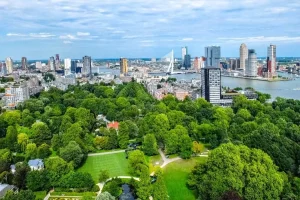
The pandemic has taught us many important lessons, one of them being that we can no longer consider urban green spaces as luxuries for the privileged few. Countless people realized the importance of having access to parks and other green spaces for physical and mental health and wellbeing, according to Discover Magazine, and it’s time to start treating those spaces as necessities, not luxuries.
University of Chicago psychologist Marc Berman told the publication that green spaces are as necessary as clean water and clean air for our ability to function well. Approximately 80% of the U.S. population live in cities; a number that continues to grow with urbanization. The catch is that access to nature is decreasing as more people flock to cities in which developing green spaces hasn’t been a priority. Furthermore, low-income groups and people of color are those with the least access to good-quality green spaces. According to U.S. News, this is one of the reasons for the greater disparity in Covid-19 infection rates between mostly white affluent areas, and lower-income areas inhabited mostly by people of color.
Link Between Low Nature Access And Poor Health
Communities of color in the U.S. experience ‘nature deprivation’ at a rate three times higher than that of white communities. According to Eco Business, a report published by the Center for American Progress and the Hispanic Access Foundation in summer 2020 also revealed that 74% of communities of color live in areas deprived of nature.
Those residents were more likely to experience poor health outcomes. Those outcomes could be mitigated by better exposure to urban green spaces. According to University of British Columbia researchers, the positive impact of exposure to urban vegetation is expected to become even more important for marginalized communities as the effects of climate change become worse.
Sustainability Is Essential
Faced with worsening climate change, it’s clear that it’s not enough to develop more green spaces in urban areas and particularly in marginalized communities. According to Triangle Business Journal, those green spaces must be sustainable.
Planting designs should aim at being durable and tough. Best practices should be taken into consideration when planning to install new plants as well as green infrastructure, with special thought given to urban forestry and managing stormwater. Professional land clearing should be part of this, as it’s important to remove invasive species, plants infected with diseases, and other potential obstacles. In order to find professionals to do the job, simply google phrases such as land clearing near me.
Community engagement is another essential aspect of developing valuable urban green spaces. Those spaces must meet the needs of the community that will use them.
Health Benefits Of Green Spaces
Health County Rankings & Roadmaps reported that there is evidence for numerous physical and mental health benefits of urban green spaces such as parks. There is a connection between those spaces and increased physical activity. This has been shown to lower childhood obesity rates and increase mental well-being in children, reduce the risk of deaths from cardiovascular diseases in adults, and positive effects on attention and mood. Lower stress, improved ADHD symptoms, and lower rates of crimes such as domestic violence. Better access to green spaces also has been linked to lower socio-economic disparities.
The last two years have highlighted inequity as well as knock-on effects of poor physical and mental health. Urban green spaces are essential for combating those social ills as well as the effects of climate change. It’s time to take them seriously.




















